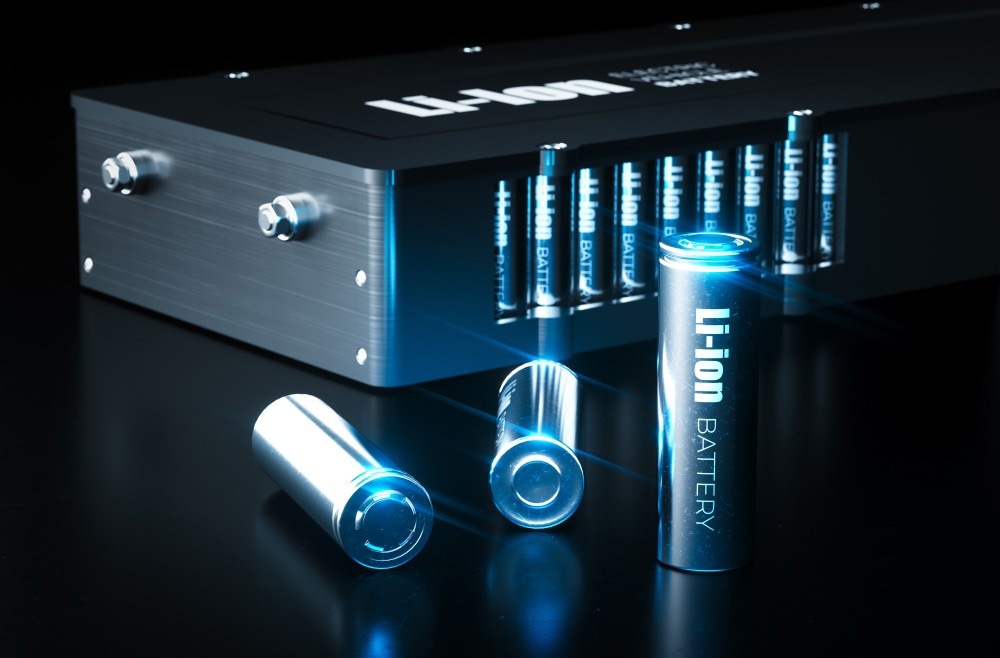A pre-proof paper from the Journal of Alloys and Compounds focuses on the production of carbon-coated iron oxide (Fe3O4) nanoparticles anchored on titanium carbide (Ti3C2) nanosheets for improved lithium (Li) storage in Li-ion batteries.

Study: Carbon-coated Fe3O4 nanocomposites anchored on Ti3C2 nanosheets for enhanced Li-storage. Image Credit: petrmalinak/Shutterstock.com
Fe3O4 is a potential anode material for reusable Li-ion batteries (LIBs) because of its substantial reversible capacity, abundant natural sources, and ease of production. However, the rated capacity and cyclic stability of the Fe3O4 electrode remain inadequate as they are hampered by its weak electrical conductivity and large volume fluctuation.
Two-dimensional (2D) nanomaterials offer exceptional energy storage applications because of their good electrical conductivity, large surface area, and mechanical strength.
Recent research has demonstrated that MXenes like titanium carbide (Ti3C2) can be employed as anode materials for Li-ion batteries (LIBs) owing to their unique features such as layered structure, high conductance, and remarkable interfacial properties.
What are Li-ion Batteries (LIBs)?
A lithium-ion battery is a rechargeable battery made up of cells in which lithium ions travel from the negative terminal to the positive terminal through an electrolyte during discharging and back again during charging. Li-ion batteries employ an interlayer lithium alloy as the positive electrode material and typically graphite as the negative electrode material.
Rechargeable LIBs have many benefits, such as high power and energy density, extended operating period, cheap cost, and environmental friendliness. They have found widespread use in electronic equipment, information systems, and aeronautical technologies.
The new-generation Li-ion batteries need quick charging and great power density, primarily due to the sudden expansion of electric vehicles. Graphite, although being the most frequently used conventional anode material, has poor rate capacities. This imposes numerous constraints on the use of Li-ion batteries in electric cars.
As a result, innovative anode materials with high-rate capacity and great cyclic stability are still needed to expand the industrial applications of Li-ion batteries.
Iron Oxide (Fe3O4) and MXenes: The Future of LIBs
Fe3O4 is an excellent alternative anode material for Li-ion batteries since its potential capacity is two times greater than graphite. However, its low intrinsic electrical conductance causes delayed reaction kinetics throughout the Li+ insertion/extraction cycle, resulting in poor rate efficiency.
Furthermore, the excessive volume variations of the Fe3O4 anode can cause a structural breakdown, reducing the cycle life of Li-ion batteries significantly.
MXene is a novel two-dimensional transitional metallic carbide material with excellent metal electrical conductance, a rich functional group composition, and excellent mechanical toughness. MXenes (such as Ti3C2) are an attractive substrate component for LIBs due to their high conductance, great chemical bonding, wettability, and abundance of functional groups.
MXene composites with novel anode materials such as Fe3O4 significantly boost the potential capacity of Li-ion batteries for energy storage and transformation applications.
Highlights of the Current Study
In this study, the researchers used an easy and reproducible acid-assisted sol-gel method to create the Fe3O4 and Ti3C2 nanocomposites. Carbon-coated Fe3O4 nanoparticles were attached to the few-layered titanium carbide nanosheets.
Citric acid serves as a binder in this procedure, integrating Fe3+ ions with Ti3C2 nanosheets. Citric acid also functions as a carbon resource to generate a carbon layer deposited on the Fe3O4 nanoparticles after high-temperature pyrolysis.
An X-ray diffractometer was used to check the crystalline phase of the nanocomposites, whereas N2 adsorption/desorption was used to measure the surface area and the pore diameter. An X-ray photoelectron spectroscope was used to carry out the valence state analysis. The lattice fringe and the element mapping were obtained from a high-resolution transmission electron microscope (TEM).
Key Developments of the Research and Future Outlook
The researchers found that the prepared Fe3O4 and Ti3C2 electrode material showed improved rate capability and cyclability compared to the traditional Fe3O4 electrode. This could be attributed to the high electrical conductivity and the robust mechanical strength of the MXene (Ti3C2) nanosheets.
The strong electrical conductance and mechanical durability of the titanium carbide nanosheets aid in the quick transmission of electrons and the integrity of the electrode structure. The carbon covering improves electrical conductivity and prevents the agglomeration of Fe3O4 nanoparticles after multiple charge/discharge cycles.
The strategy proposed in this study could also be extended to prepare other electrochemical active substances and MXene nanocomposites, paving the way for future industrial energy storage applications of Li-ion batteries.
Reference
Xiu, Z. et al. (2022). Carbon-coated Fe3O4 nanocomposites anchored on Ti3C2 nanosheets for enhanced Li-storage. Journal of Alloys and Compounds. Available at: https://www.sciencedirect.com/science/article/pii/S0925838822024598?via%3Dihub
Disclaimer: The views expressed here are those of the author expressed in their private capacity and do not necessarily represent the views of AZoM.com Limited T/A AZoNetwork the owner and operator of this website. This disclaimer forms part of the Terms and conditions of use of this website.